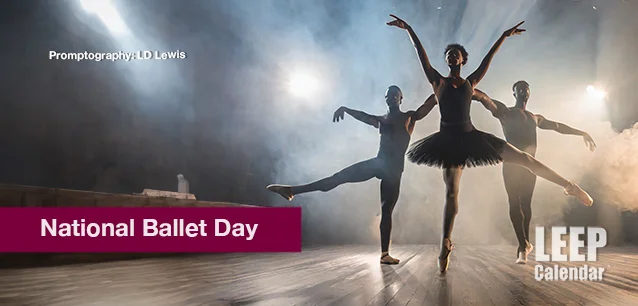 AD
AD
Today is: November 25
Scroll to explore events active on this date.
LEEP INK FEATURES

Nuanced November 2024
November is the start of the holiday season in many parts of the world. It is a time for family, football, food, shopping and decorating, particularly in the Christian and Jewish world, leading to Christmas and...

December's Gift
Events in December 2024. Well, we made it to December. December is the holiday season, particularly in Western nations, where Christianity and Judaism are the faiths most common in the nation's past. ...

August is Appropos
A toddler playing in the fountain at a park in Santa Fe, New Mexico—Photo LD Lewis. In August, we live through the Dog Days of Summer. It's hot and often humid, and those ...
About National Ballet Day
Entertainment , Music
United States
Ends: Feb 07, 2025
DESCRIPTION:
National Ballet Day is an unofficial event dedicated to the art of ballet, a form of artistic dance known for its grace, precision, and fluidity of movement. This day is an opportunity for ballet enthusiasts, dancers, choreographers, and audiences to honor the rich history of ballet and its enduring impact on the world of dance and beyond.
Ballet originated during the Italian Renaissance in the 15th century and was developed further in France and Russia as a concert dance form. It began as a courtly dance among the aristocracy, a spectacle of elegance and refinement. "ballet" comes from the Italian word "ballo," which means to dance.
In the 16th century, Catherine de Medici, an Italian noblewoman who became the queen of France, was instrumental in promoting and financing ballet in the French court. Ballets at this time were lavish events intertwined with vocal and orchestral music, drama, and elaborate costumes and scenery. During the reign of Louis XIV in the 17th century, ballet began to take the form we recognize today. Louis XIV, an accomplished dancer, established the first ballet academy in 1661, the Académie Royale de Danse.
The 18th and 19th centuries saw ballet evolve significantly, with the introduction of new techniques and the emergence of the ballerina as the central figure in performances. This era marked the shift from courtly performances to public theater. Ballet gained prominence as an art form in its own right during this period, with the development of pointe work (dancing on toes), a more codified technique, and the emergence of narrative-driven ballets.
Ballet reached new heights of popularity in the late 19th and early 20th centuries, particularly with the influence of the Russian Imperial Ballet and choreographers like Marius Petipa, who created classics such as "The Nutcracker," "Swan Lake," and "The Sleeping Beauty." The 20th century saw further evolution with the introduction of modern and contemporary styles, challenging traditional norms and expanding the expressive range of the art form.
National Ballet Day acknowledges this rich history and the artistry, discipline, and athleticism required in ballet. Celebrations include performances, workshops, educational outreach, and sharing the joy of ballet with a broader audience through various media platforms. This day underscores ballet's role in cultural history and its relevance and beauty as artistic expression.
VIDEOS
SUPPORTING DOCUMENTS
Currently, this event does not have supporting documents.
ADDITIONAL IMAGES
Currently, this event does not have supporting images.
Where would you like to go now?
 AD
AD


/footer-logo.svg)
